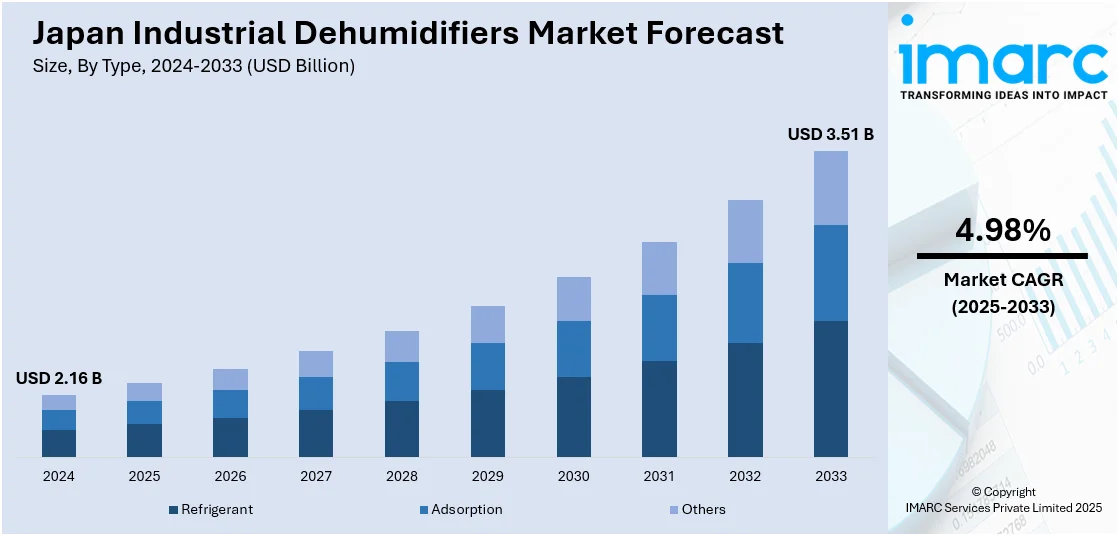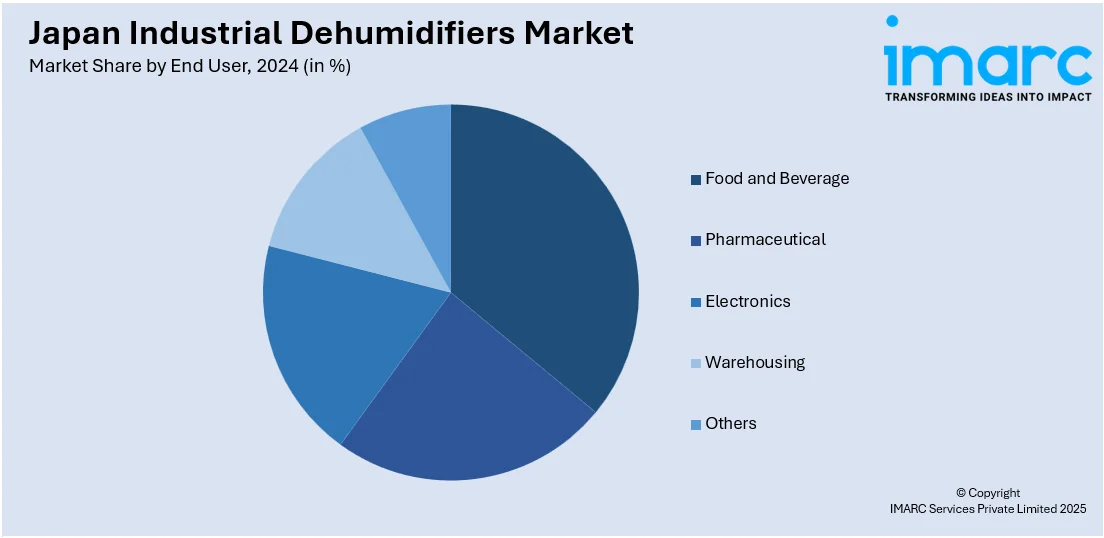
Japan Industrial Dehumidifiers Market Size, Share, Trends and Forecast by Type, Installation, End User, and Region, 2025-2033
Japan Industrial Dehumidifiers Market Overview:
The Japan industrial dehumidifiers market size reached USD 2.16 Billion in 2024. Looking forward, IMARC Group expects the market to reach USD 3.51 Billion by 2033, exhibiting a growth rate (CAGR) of 4.98% during 2025-2033. The market is witnessing significant growth driven by rising demand across manufacturing, food processing, and pharmaceutical sectors, where controlled humidity is essential for product quality and equipment longevity. Energy-efficient models and smart humidity control systems are also gaining traction amid growing environmental regulations. Increasing investments in industrial infrastructure and technological upgrades collectively influence the overall Japan industrial dehumidifiers market share.
|
Report Attribute
|
Key Statistics
|
|---|---|
|
Base Year
|
2024
|
|
Forecast Years
|
2025-2033
|
|
Historical Years
|
2019-2024
|
| Market Size in 2024 | USD 2.16 Billion |
| Market Forecast in 2033 | USD 3.51 Billion |
| Market Growth Rate 2025-2033 | 4.98% |
Japan Industrial Dehumidifiers Market Trends:
Rising Adoption of Energy Efficient Models
The Japanese industrial dehumidifiers market is experiencing a definite trend towards energy efficient models as industries seek to lower operational expenses and comply with strict energy consumption standards. Manufacturers are now more focused on creating dehumidifiers that provide maximum performance while consuming much less power. This trend is particularly applicable in Japan where energy efficiency is a priority because of economic as well as environmental reasons. Pharmaceutical, food processing, and electronics manufacturing industries need constant humidity control rendering power consumption an influential cost factor. Energy efficient dehumidifiers help companies lower electricity bills and also align with national sustainability goals and carbon reduction targets. Technological advancements such as variable speed compressors and advanced sensor-based control systems are playing a crucial role in improving the energy performance of these units. As a result, energy-efficient dehumidifiers are becoming the preferred choice across multiple industrial applications in Japan.

Integration of Smart Controls
Smart control integration is becoming a defining trend significantly contributing to Japan industrial dehumidifiers market growth. With the rise of Industry 4.0 and automation manufacturers are embedding IoT-enabled systems and digital interfaces into dehumidifiers to enable real-time monitoring, data logging, and remote operation. These smart features allow facility managers to track humidity levels, machine performance, and energy usage from centralized dashboards or mobile devices improving operational efficiency and response times. Predictive maintenance capabilities further reduce downtime by alerting users to potential issues before they escalate. This is particularly valuable in critical sectors like pharmaceuticals, electronics, and food processing where environmental conditions must be tightly regulated. The demand for connected and intelligent equipment aligns with Japan’s broader push toward smart manufacturing reinforcing the adoption of advanced dehumidifiers.
Rising Demand from Pharmaceutical and Food Processing Industries
The pharmaceutical and food processing industries are key drivers of demand in the Japan industrial dehumidifiers market fueled by strict humidity control standards. In pharmaceutical manufacturing precise humidity levels are essential to ensure drug stability, prevent microbial contamination, and maintain the integrity of active ingredients. Similarly, the food processing sector requires controlled environments to extend product shelf life, maintain texture and flavor, and comply with hygiene regulations. Japan's aging population and growing health awareness are spurring pharmaceutical production while consumer demand for packaged and processed foods continues to rise. These trends are placing greater emphasis on environmental control within production and storage facilities. Industrial dehumidifiers offer reliable solutions to maintain optimal conditions, reduce spoilage, and meet regulatory requirements. As these sectors expand and modernize the need for high-performance and energy efficient dehumidification systems is directly supporting market growth and investment.
Japan Industrial Dehumidifiers Market Segmentation:
IMARC Group provides an analysis of the key trends in each segment of the market, along with forecasts at the country and regional levels for 2025-2033. Our report has categorized the market based on type, installation, and end user.
Type Insights:
- Refrigerant
- Adsorption
- Others
The report has provided a detailed breakup and analysis of the market based on the type. This includes refrigerant, adsorption, and others.
Installation Insights:
- Floor
- Ceiling
A detailed breakup and analysis of the market based on the installation have also been provided in the report. This includes floor and ceiling.
End User Insights:

- Food and Beverage
- Pharmaceutical
- Electronics
- Warehousing
- Others
A detailed breakup and analysis of the market based on the end user have also been provided in the report. This includes food and beverage, pharmaceutical, electronics, warehousing, and others.
Regional Insights:
- Kanto Region
- Kansai/Kinki Region
- Central/Chubu Region
- Kyushu-Okinawa Region
- Tohoku Region
- Chugoku Region
- Hokkaido Region
- Shikoku Region
The report has also provided a comprehensive analysis of all the major regional markets, which include Kanto Region, Kansai/Kinki Region, Central/Chubu Region, Kyushu-Okinawa Region, Tohoku Region, Chugoku Region, Hokkaido Region, and Shikoku Region.
Competitive Landscape:
The market research report has also provided a comprehensive analysis of the competitive landscape. Competitive analysis such as market structure, key player positioning, top winning strategies, competitive dashboard, and company evaluation quadrant has been covered in the report. Also, detailed profiles of all major companies have been provided.
Japan Industrial Dehumidifiers Market Report Coverage:
| Report Features | Details |
|---|---|
| Base Year of the Analysis | 2024 |
| Historical Period | 2019-2024 |
| Forecast Period | 2025-2033 |
| Units | Billion USD |
| Scope of the Report |
Exploration of Historical Trends and Market Outlook, Industry Catalysts and Challenges, Segment-Wise Historical and Future Market Assessment:
|
| Types Covered | Refrigerant, Adsorption, Others |
| Installations Covered | Floor, Ceiling |
| End Users Covered | Food and Beverage, Pharmaceutical, Electronics, Warehousing, Others |
| Regions Covered | Kanto Region, Kansai/Kinki Region, Central/Chubu Region, Kyushu-Okinawa Region, Tohoku Region, Chugoku Region, Hokkaido Region, Shikoku Region |
| Customization Scope | 10% Free Customization |
| Post-Sale Analyst Support | 10-12 Weeks |
| Delivery Format | PDF and Excel through Email (We can also provide the editable version of the report in PPT/Word format on special request) |
Key Questions Answered in This Report:
- How has the Japan industrial dehumidifiers market performed so far and how will it perform in the coming years?
- What is the breakup of the Japan industrial dehumidifiers market on the basis of type?
- What is the breakup of the Japan industrial dehumidifiers market on the basis of installation?
- What is the breakup of the Japan industrial dehumidifiers market on the basis of end user?
- What is the breakup of the Japan industrial dehumidifiers market on the basis of region?
- What are the various stages in the value chain of the Japan industrial dehumidifiers market?
- What are the key driving factors and challenges in the Japan industrial dehumidifiers market?
- What is the structure of the Japan industrial dehumidifiers market and who are the key players?
- What is the degree of competition in the Japan industrial dehumidifiers market?
Key Benefits for Stakeholders:
- IMARC’s industry report offers a comprehensive quantitative analysis of various market segments, historical and current market trends, market forecasts, and dynamics of the Japan industrial dehumidifiers market from 2019-2033.
- The research report provides the latest information on the market drivers, challenges, and opportunities in the Japan industrial dehumidifiers market.
- Porter's five forces analysis assist stakeholders in assessing the impact of new entrants, competitive rivalry, supplier power, buyer power, and the threat of substitution. It helps stakeholders to analyze the level of competition within the Japan industrial dehumidifiers industry and its attractiveness.
- Competitive landscape allows stakeholders to understand their competitive environment and provides an insight into the current positions of key players in the market.
Need more help?
- Speak to our experienced analysts for insights on the current market scenarios.
- Include additional segments and countries to customize the report as per your requirement.
- Gain an unparalleled competitive advantage in your domain by understanding how to utilize the report and positively impacting your operations and revenue.
- For further assistance, please connect with our analysts.
 Request Customization
Request Customization
 Speak to an Analyst
Speak to an Analyst
 Request Brochure
Request Brochure
 Inquire Before Buying
Inquire Before Buying




.webp)




.webp)












